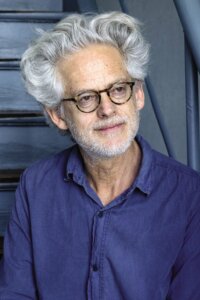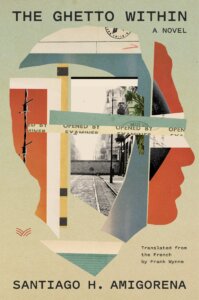He escaped one ghetto only to find himself imprisoned in another
Santiago Amigorena’s novel imagines his grandfather’s life in Argentina and the one he left behind in Poland

A Nazi soldier checks someone’s papers in Warsaw’s Jewish ghetto during World War II. Photo by Getty Images
The Ghetto Within
By Santiago H. Amigorena; translated from the French by Frank Wynne
HarperVia, 176 pages, $25.99
Santiago H. Amigorena’s ongoing literary project, he writes, has been “to oppose the silence that has stifled me since birth.” “The Ghetto Within,” he suggests in a preface, is the project’s origin story.
That story is at first coolly told, a catalog of quotidian events. But as the narrative gathers momentum, it becomes more abstract and lyrical. In the book’s final pages, Amigorena describes a Parisian sky streaked with “blood and honey” — a memorable image that links his present anguish to his family’s earlier ordeals.
In this account, the author’s grandfather, Vicente Rosenberg, migrates to Buenos Aires in 1928, fleeing Polish antisemitism and seeking personal independence. His wealthy Polish Jewish family remains behind in Warsaw. Vicente quickly embraces the pleasures of the Argentinian capital. But his happiness begins to erode as his family’s fate grows uncertain. Eventually, his mother’s intermittent, harrowing letters from the Warsaw Ghetto constitute his only proof of life.
“The Ghetto Within,” the Argentine-French director’s English-language debut, is billed as a novel. But the reader’s presumption is that it describes Amigorena’s actual backstory. Its narrative has elements of history, biography, memoir, even media critique — as if no single genre suffices to contain, or express, the intergenerational trauma of the Holocaust.

The freedoms of fiction allow the author to penetrate his grandfather’s psyche, delineating his torments as he awaits word from his mother. Amigorena is at his most inventive when he describes Vicente’s nightmares, in which he is entombed within his own body — the ghetto within — and tries to fight his way out. He also imagines Vicente’s overwhelming guilt at having left his mother behind in Poland, and the impact of his increasingly impenetrable silence on those around him.
The story’s outlines are biography: the tale of a successful furniture salesman content in his vocation, his friendships and his passionate marriage to an Argentinian woman, with whom he has two daughters and a son. Until the mounting crisis in Europe becomes impossible to ignore.
Amigorena interrupts his narrative with historical and philosophical digressions, detailing the construction of the ghettos and the death camps, the inability of language to adequately describe the catastrophe, the efforts by many to remain ignorant. Vicente, he suggests, is initially among them, thinking that “it served no purpose to be informed.”
Amigorena’s insertion of himself into the story near the end marks a turn toward memoir — and a reminder of the tragedy’s continuing reverberations.
The novel starts in September 1940, with “the war in Europe so remote that one might still have thought it was peacetime.” Thirty-eight-year-old Vicente, on his way to a fashionable café, is described as “a young Jew. Or a young Pole. Or a young Argentinian” — in short, a man who “did not yet know quite what he was.” The complexity of identity, particularly Jewish identity, is one of the novel’s themes.
Since his departure for Argentina, Vicente’s mother has written him frequently, but he often has been dilatory in his responses. With Europe in crisis, however, “it was he who worried because he had no news from his mother.”
When he finally gets a letter, his mother tells him how difficult it is to find food in the ghetto. Guilt starts to consume him. “In 1928, being apart from his mother had been a relief – now being apart from her was torture,” he thinks. As the news worsens, he feels “a twofold self-hatred: he would hate himself because he had felt Polish, and he would hate himself still more because he had wanted to be German.” Now, “suddenly, being Jewish had become the only thing that mattered.”

The situation in Europe becomes Vicente’s obsession, along with his Jewish identity: an “immense, unwieldy heritage,” akin to “a huge trunk filled with manuscripts scrawled with illegible writing.” He tells his two inveterate café companions: “We were chosen, but we have never really known why.”
In October 1941, an even grimmer letter from his mother arrives, describing starvation and despair in the ghetto. After that, he begins to find words unendurable. He scours the newspapers, which “made it possible for Vicente to know — and not to know.” As with the plight of those “disappeared” by the military junta in Buenos Aires four decades later, Amigorena writes, “people preferred to say nothing, to know nothing.”
Hearing only silence from his family, Vicente himself begins to long for “a silence so powerful, so constant, so insistent, so relentless that all things would become remote, invisible, inaudible – a silence so deep-rooted that everything would be lost in a blizzard of snow.”
He ignores his wife and children, neglects his business, spends his nights gambling and losing money. Language fails him. After an escapee from Warsaw pays him a visit, detailing the ghetto’s miseries, Vicente sees a sky “the color of honey and blood,” as the day — and the world he left behind — slowly dies. Eventually, as Amigorena tells it, his grandfather remains enveloped in silence, passing on a legacy of sorrow and guilt that his descendants must struggle to overcome.
















